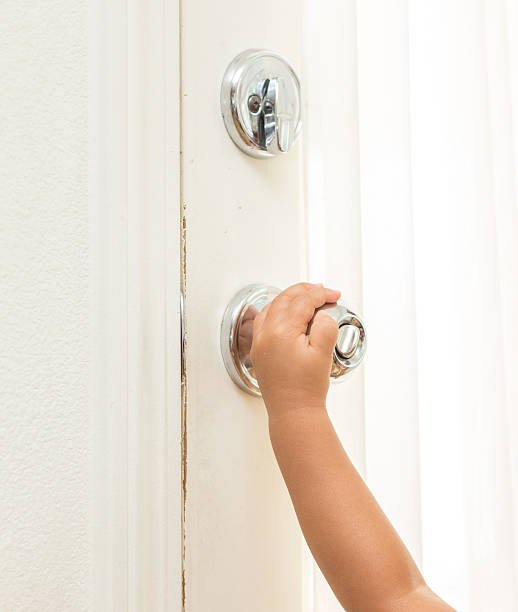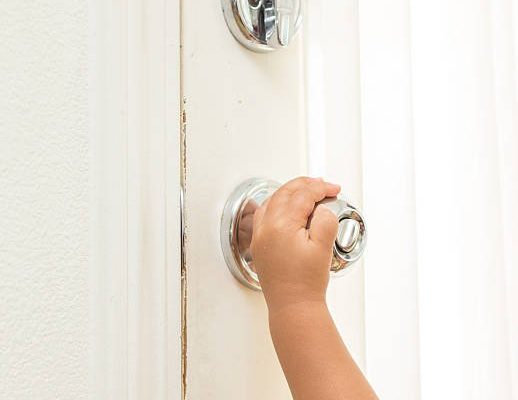
Here’s the thing: there are a bunch of small factors hiding inside that pretty handleset. Some involve the physical strength needed, while others come down to design quirks. This isn’t just about “kids are too small”—it’s also about how the knob, lock, and latch actually work together. Let’s break down the real reasons why that door knob might be hard for little hands to turn, and what you can do about it.
How Handleset Door Knobs Work (And Why They Can Feel Stiff)
Before we dig into the troubleshooting, it helps to know what’s going on inside that knob. Honestly, a handleset looks simple from the outside, but under the shiny hardware, a bunch of moving parts work together every time you turn it.
Most handleset door knobs use a turning mechanism that rotates a spindle, which slides the latch bolt back and lets the door open. Brand-specific designs from names like Schlage or Kwikset sometimes add extra steps—a built-in lock or a thumb-turn on the other side. Now, if any small piece inside is tight, misaligned, or clogged up, that resistance multiplies at the knob. What feels like mild friction to an adult can become a real roadblock for child-sized hands.
You might be wondering: why does it get so tough? Over time, dust, sticky grime, or even wear and tear can clog the latch or inner spring. This happens in both standard and smart lock handlesets (think Yale or August). If it takes extra force for you, imagine what a child is up against with that same knob.
Grip Strength: The Unsung Issue With Handlesets
Let me explain something most adults forget: children’s hands just aren’t as strong or coordinated as ours. Doors that seem “normal” for us often need more muscle than we think. Handleset knobs tend to be bulkier and require a full grip—sometimes with a twist and a push at the same time.
- Large diameter knobs are harder for kids to grip fully.
- Spring-loaded mechanisms can take more force to turn.
- Vertical handles or lever designs are sometimes easier, but not always available on entry doors.
There’s also a safety aspect here. Some brands intentionally make exterior handlesets stiffer to prevent easy opening by toddlers or intruders. It’s a double-edged sword: you get more security, but less kid-friendliness. For a child who’s eager to open the door themselves, this can be pretty frustrating (and it can lead to some creative “hacks” involving stools or toys, which often don’t end well).
Common Mechanical Problems That Cause A Stiff Handleset
A stiff or hard-to-turn handleset knob isn’t always about small hands. Sometimes, the problem is hiding inside the lock. Here’s what to look for if your Kwikset, Schlage, or similar brand is putting up a fight:
- Dirt and debris: Over time, dust and grime build up inside the latch. This adds friction, which makes the turn harder for everyone—especially kids.
- Lack of lubrication: Dry or squeaky inner parts increase resistance. A simple squirt of graphite or silicone lubricant (never oil) can do wonders.
- Worn-out springs: If the internal springs are wearing out, the mechanism doesn’t “pop” back easily. The knob feels heavy and sluggish.
- Misaligned strike plate or latch: If the door wasn’t installed just right, the latch rubs or catches every time. This extra drag definitely makes things tough for children.
Here’s a tip: Try turning the knob with the door open. If it moves easily in this position, the issue is probably alignment, not the actual knob or code mechanism. If it’s still stiff, the problem is inside the handleset itself.
Design Differences: Handlesets vs. Levers vs. Smart Locks
You might be wondering if all door knobs are equally tough for kids. Here’s where design comes into play. Handlesets with round knobs are generally harder for young children than lever handles or electronic smart locks.
- Lever-style handles let you push down with your body weight. This is way easier for little ones (and people with limited hand strength).
- Traditional round or oval handlesets require a full twisting grip and often more wrist strength.
- Smart locks (like Yale or August) usually have touchpads or keycode entry. But most still have a physical handle or knob for the main latch—so the same mechanical issues can apply.
If you have a universal remote-style smart lock, remember that the unlocking code or sync process only controls the deadbolt, not the knob itself. So even after you “pair” and unlock the door, physically turning that handleset knob is the same challenge for little hands.
When Brand and Model Matter: Schlage, Kwikset, Yale, and Others
Not all handlesets are built the same. Some brands are known for a smoother action, while others have tighter, more secure fits. Schlage handlesets tend to use heavier internal springs for security. Kwikset models sometimes feel lighter, but their lock code and reset features don’t always affect the knob’s resistance.
Even with the fanciest remote or smart features, if the basic handleset design is stiff, kids will have a hard time turning it.
Some designs have adjustment screws or removable inserts that can (slightly) change the turning resistance. This is more common on high-end or universal models. Yale’s more recent smart locks have a smoother thumb-turn on the inside, but older units are known to be stiffer.
Want an easier option? Lever handles, especially ADA-rated models, are built for low resistance. If you’re thinking about changing things up, check if your door’s cutout supports a lever kit from your brand.
Can You Fix a Stiff Handleset For Kids? (Troubleshooting Tips)
If your handleset door knob is tough for kids, there are a few things you can try before swapping out the whole thing:
- Lubricate the mechanism. Use a graphite or silicone spray—never WD-40 or oil, as these attract more dirt. Spray lightly into the latch and work the knob back and forth.
- Check alignment. With the door open, try the knob. If it’s smooth, the latch or strike plate may be misaligned. You can adjust the strike plate screws or file the opening slightly for less friction.
- Tighten or loosen the handle screws. Sometimes overtightening causes extra drag. Loosen a quarter turn and test again.
- Replace worn parts. Springs, latches, or even the whole handleset can be swapped—especially if yours is old or stuck.
If you’ve got a smart handleset (with code or battery functions), check if a low battery or jammed motor is adding resistance to the lock mechanism, but again, mechanical stiffness usually comes down to the physical parts, not the electronics.
When Should You Replace Versus Repair?
Here’s where you make the call. If you’ve tried lubricating, cleaning, and adjusting everything, and the knob is still tough for kids, replacement might be the best option. Some models just aren’t built with young hands in mind.
- If the knob feels gritty, grinds, or “catches” every turn, internal parts could be worn beyond fixing.
- If your handleset is older (more than 10–15 years), new models from the same brand might have improved mechanisms.
- If you want something truly child-friendly, swap to a lever handle or a smart lock that only relies on a code or remote for entry—not twisting a stiff knob.
For families, it’s not just about ease. It’s about safety. If a child needs to get out fast, you want a door knob they can actually turn on their own.
Kid-Friendly Alternatives and Long-Term Solutions
If you’re tired of watching your child struggle with the handleset door knob, a few longer-term upgrades could make life easier:
- Switch to a lever-style handle. These are easier for everyone—not just kids, but also people with arthritis or limited grip strength.
- Install an ADA-compliant handleset. These are literally built for easy use and lower resistance.
- Opt for a smart lock with a push-to-open feature. Some Yale or August models let you unlock with a code or remote and then just push the door open, skipping the twist altogether.
- Teach your child the best technique. Sometimes, using two hands or pushing/pulling the door slightly as they turn the knob helps the latch disengage with less force.
Remember, if your home has universal or brand-specific remotes for entry (like garage or front door), check that the physical knob is easy enough for your child to use once the code or sync is successful. There’s no point in unlocking the door if you’re still stuck at the handleset stage.
Final Thoughts: Balancing Security and Accessibility
Door knobs seem boring until someone can’t open one—and for families with kids, the struggle is real. Brands like Kwikset, Schlage, and Yale build for security, but they don’t always nail ease-of-use for little hands. If your handleset door knob is hard for children to turn, it’s usually a mix of physical design, mechanical wear, and a bit of safety-focused stubbornness built in.
Whether you choose to lubricate, realign, or upgrade your setup, the goal is a door that opens smoothly for everyone in the family. Sometimes, something as simple as a new handle or smart lock can make your mornings—and your child’s confidence—run a whole lot smoother.
